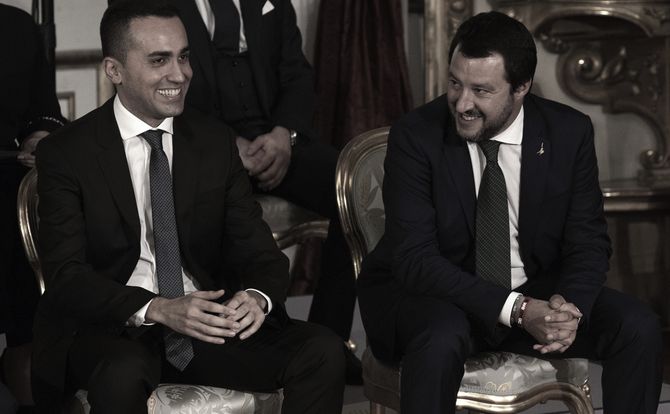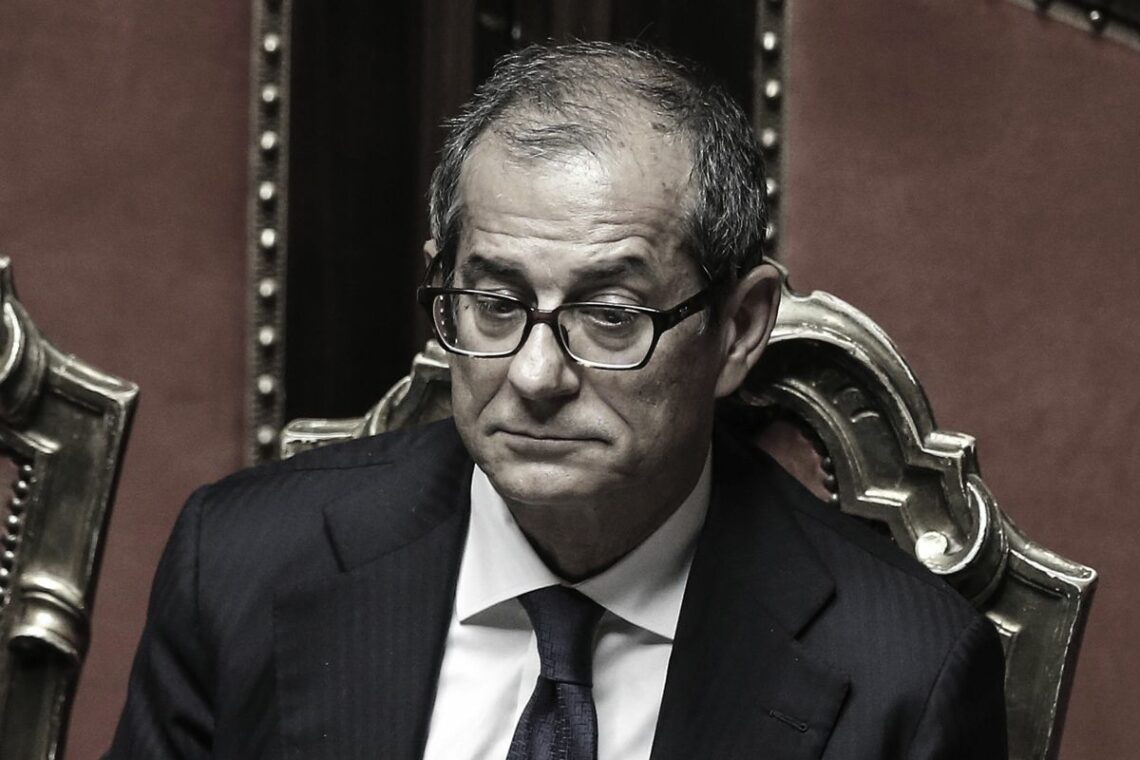Italy at risk
Italy’s new left-right government is a political experiment that could turn out as a disguised version of business as usual or a complete disaster. Many observers assumed that Lega leader Matteo Salvini would manufacture the disaster on purpose.

In a nutshell
- Italy’s left-right ruling coalition caters to very different populist constituencies
- The poor state of the economy and public finances gives little room of maneuver
- Lega leader Matteo Salvini has shelved his anti-euro plans, but time may be his ally
The Italian experiment with a left-right populist government could end up as a disguised version of more business as usual, or in an utter disaster. Before the cabinet was formed, quite a few observers assumed a disaster would result – purposely manufactured by Lega leader Matteo Salvini as a way of forcing the country out of the euro area and reestablishing what populists call “monetary sovereignty.” Now, however, it appears the financial crisis is more likely to come by accident than by design.
It took two months for Italy to form a new government from populist parties of the left and right. This is happening in a delicate moment for the country. While the gross domestic product (GDP) started growing again in 2017, the state of Italy’s public finances remains shaky and the private economy seems fragile, too, as growth estimates for this year have been lowered.
Vulnerable economy
Economic expansion of 1.7 percent last year may not seem impressive by Chinese standards, but it is no mean accomplishment in a country where literally everything – from demography to byzantine regulations – conspires against growth.
In any case, national averages are deceiving in a country as profoundly divided as Italy. Overall growth of 1.7 percent masks a much stronger performance in the prosperous northern regions, while the country’s south is stuck with zero development, high unemployment and a weak rule of law.
Earlier this year, the stock market appeared to be performing well; exports were thriving and the country had posted a current account surplus of 2.6 percent of GDP. Yet Italy’s banking sector remains highly fragmented, weakly capitalized and burdened by nonperforming loans.
Italy’s public spending and debt ratios leave the country highly vulnerable to external shocks.
As for public finances, the new government may be promising bold steps, but public spending is already at 50.2 percent of GDP and public debt at 132 percent. These ratios leave Italy highly vulnerable to external shocks. The country has been a key beneficiary of the European Central Bank’s nonconventional monetary policy, which has dramatically lowered debt service costs to the budget. Yet the ECB is expected to start winding down so-called quantitative easing by early next year.
While Italy’s new rulers have repeatedly deplored the depressing effects of “austerity,” genuine austerity – meaning rigorous curbs on the budget deficit – was already over in 2014.
Strange coalition
In the March 4 general election, the Five Star Movement (M5S) won big in the south on a platform promising government interventionism and, especially, a basic income for everybody, estimated at 780 euros per person ($910). The Northern League, transformed into a full-fledged nationalist party by Mr. Salvini and rebranded as Lega (The League), remains strong in the north with its call for lower taxes and curbs on immigration.
While M5S also attracts voters who used to self-identify as right-wingers, its positions largely overlap with those of the traditional, extreme left. Lega, on the contrary, can be classified by European standards as belonging to the nationalist right.
For all their different backgrounds, both parties share a similar sense of grievance against so-called mainstream politics. Italy’s revamped electoral law of 2017 – an intricate mixture of proportional representation (63 percent of parliament) and first-past-the-post, single-member districts (37 percent) – also enabled and encouraged this ill-assorted coalition.
To save face with their respective constituencies, the two ruling parties needed to draft a “contract” as a broad guideline of future government action. As with all political agendas, it was mostly about signaling; the coalition should not be expected to follow it verbatim. Nevertheless, were the program fully enacted, the additional costs to the state budget are estimated at about 125 billion euros. This would be tantamount to a 15 percent increase in public spending. That is incompatible with common sense, let alone the fiscal rules set forth by the European Union’s Stability and Growth Pact.
Difficult situation
The new “populist” government thus finds itself in a very tight spot. Both its leaders, Mr. Salvini of the League and Luigi Di Maio of M5S, have made very expensive promises. The possibility that dramatic tax cuts, or even a more rational welfare system, may have positive effects on economic growth and thus help in making the debt sustainable cannot be altogether ruled out. But at bottom, it is a question of magnitude – the budget numbers do not add up.
The new minister of economy and finances, Giovanni Tria, is no extremist. He is a Keynesian of conservative persuasion, who has so far preached, credibly, the gospel of prudence. Any tax-cutting measures have been officially postponed until 2019, as has the universal basic income scheme.

Mr. Tria seems wedded to a policy of gradually but steadily reducing the budget deficit. The Italian constitution calls for a balanced budget, but nobody cares. European rules can always be renegotiated. But with foreigners holding one-third of Italian public debt, and with government bonds representing nearly 20 percent of the assets held by Italian commercial banks, it is markets that must be watched.
The previous government of Prime Minister Paolo Gentiloni (2016-2018) forecast that the fiscal deficit would narrow to 1.6 percent of GDP in 2018. However, the economic outlook is worsening. Rising protectionism will negatively affect exports, and uncertainty about the manufacturing sector has already begun to hurt shares of domestic banks. Ita-coin, a cyclical leading indicator used by the Bank of Italy, over the last few months has pointed to slowing growth.
In this context, it would be no surprise if Mr. Tria were forced to announce a wider-than-expected fiscal deficit. The market reaction will depend on just how much bigger that number will be.
Scapegoats or stability
Before agreeing to the more conventional Mr. Tria, Mr. Salvini of Lega had originally wanted Paolo Savona – an 81-year-old technocrat and banker – for the economy and finance portfolio. Mr. Savona has had a distinguished career in business and government, but he was considered for a cabinet post because he is the most prominent figure in Italian financial circles to openly question the viability of the euro. Among the single currency’s fiercest critics, he was perhaps the only one with the resume for the job.
Mr. Savona has spoken publicly about Italy’s need for a secret plan to leave the euro area if things go wrong. Whatever the merits of this suggestion, voicing it in public raised deep suspicions about Mr. Savona’s (and Italy’s) dependability and contributed to a sharp widening in the spread between Italian and German government bonds.
Leaving the euro to inflate a national currency will relieve public finances, but levy a heavy wealth tax on households.
The Five Star Movement once advocated a referendum on the euro (forbidden by Italy’s constitution in the case of international treaties), but that was a while ago. In the recent election campaign, Mr. Di Maio explicitly ruled out an “Italexit” and posed as a committed europhile. Mr. Salvini, until recently a member of the European Parliament, appeared to be a far more committed euroskeptic.
It is often remarked that Italy is a country of savers: its median household wealth is around 163,400 euros, as compared to 51,400 euros in Germany. Until very recently, the country had high saving rates – a lasting legacy of its peasant mindset (Italy industrialized late and abruptly, between the 1950s and 1970s). Since 2009, however, the European debt crisis has depressed the savings rate and undermined confidence in financial institutions.
Still, such a high median wealth (mostly due to a high homeownership rate) makes Italy an unlikely candidate to leave the euro area. The constantly depreciating lira was one of the reasons Italians used to save a lot; they should be grateful for the price stability bestowed by the single currency. Leaving the euro to inflate a national currency will provide relief to public finances, but levy the equivalent of a heavy “wealth tax” on households.
Even so, countries in crisis may need scapegoats more than price stability. European institutions and the common currency, once hugely popular, are now considered a hindrance by half of the population, according to opinion polls.
Is that enough for Mr. Salvini to stage an “Italexit?”
Evolving in office
Lega supporters are highly concentrated in the richest parts of Italy. While it may be questionable for Naples to have the same currency as Munich, it makes plenty of sense for Milan to use the same money as Frankfurt. Northern Italy has been one of Europe’s wealthiest regions since the 14th century. Its most thriving businesses are exporters, which trade heavily with the rest of Europe and form an essential link in the supply chain of many German companies. For these firms, access to the common market is crucial – and they know they would certainly lose that access if Italy quit the common currency.
Mr. Salvini’s anti-euro rhetoric has evolved over time. In the beginning, he wanted monetary sovereignty to boost exports; but exporters have managed to help themselves quite well. More recently, he has used the euro as a scapegoat for the general underperformance of the Italian economy. This tactic for widening his base of support has enjoyed a certain success.
It is by no means clear that euroskepticism is what drew voters to Mr. Salvini. They most probably chose Lega because it promised lower taxes, a hard line on immigration and a lower retirement age.
Mr. Salvini has quickly grasped that immigration, not the euro, is key to maximizing his party’s popularity.
As minister of the interior, Mr. Salvini has focused on immigration, refusing to let a ship carrying 629 refugees and migrants dock in the country. After the vessel was successfully diverted to Spain, he instantly became a popular hero and living proof that Italy could improve its bargaining position vis-a-vis the other EU member states by raising its voice. It appears that Mr. Salvini has quickly grasped that immigration, not the euro, is key to maximizing his party’s popularity. The latest opinion polls show that support for Lega has climbed to nearly 30 percent, from its March 4 election result of 17 percent.
While Lega’s leader is avoiding economic battles, Mr. Di Maio of M5S – who has taken the industry and welfare portfolio – seems to welcome them. So far, he has talked about something resembling a minimum wage for food delivery workers (who number less than 10,000 in all of Italy), “a new business model for telecommunications” (yet to be defined), and introducing mandatory limits on shop opening hours. His first government decree, aiming at restoring “dignity” to workers of precarious job status, explicitly aimed to reduce flexibility in the labor market.
One of the few electoral mantras shared by both coalition parties is pension reform. But lowering the retirement age seems a risky proposition for a country with a low fertility rate that is determined to curb the migrant influx.
Crisis by design – or accident
A scenario in which Italy purposefully exits the euro, which seemed implicit in Mr. Salvini’s support for the candidacy of Mr. Savona (who ended up as minister of European affairs, a relatively junior position in the cabinet), no longer seems probable. The more likely risk is that the two government leaders, despite their prudent finance minister, might inadvertently trigger a crisis.
Since markets are paying very close attention to Italy, an incautious word might suffice. The strange composition of the government makes this more likely. Usually, demagogic policies are born from bidding wars during election campaigns, as parties on opposite sides vie for popular support. The first few weeks of Italy’s new government suggest this may become the rule among the ruling coalition partners – a new wrinkle in European politics.
A cabinet crisis cannot be ruled out. If Lega continues to gather support, the leadership of M5S may become increasingly uneasy about continuing an experiment that – on issues such as immigration – is clearly promoting right-wing policies. A good chunk of the Italian political establishment would clearly welcome such a scenario, as either party would look less threatening in a different coalition: M5S as an ally of the declining Democratic Party, or Lega supported by Silvio Berlusconi’s Forza Italia. Both of these prospective partners have government experience lacked by the dilettantes now in charge,
This highlights what is likely to remain the key structural weakness of Italy’s odd ruling coalition. If the experiment benefits one partner too much, the other may be tempted to jump ship and support a technocratic government with the old-guard parties. This maneuver would calm European partners nervous about Italy’s policies on immigration and the euro, but – if carried out by M5S – could pave the way for a pro-Lega landslide at the next elections.








